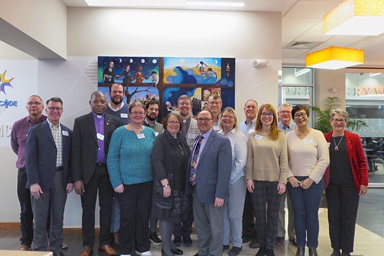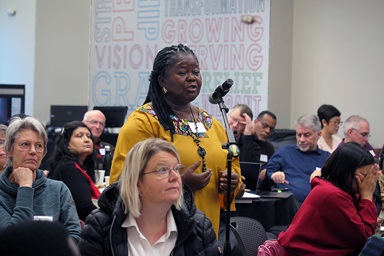Sometimes a simple act, like the folding of paper into an origami crane, can make a prayer more tangible.
As a native Hawaiian of Japanese descent, the Rev. Bob Hoshibata has practiced origami, the art of paper-folding, all his life. He finds the practice provides a “centering” for him — a quiet, meditative way to keep his hands busy while his mind is focused.
In the weeks leading up to the United Methodist Church’s lawmaking assembly, Hoshibata has been folding cranes. The superintendent of the church’s Seattle District, he is also a delegate to the gathering.
Now other members of the Pacific Northwest delegation are folding also. Together, the delegation plans to fold 1,001 cranes as prayers for peace before and during General Conference. The assembly meets April 27-May 7 in Pittsburgh.
In Japanese culture, the crane is a symbol of peace and long life. Cranes are said to live for 1,000 years, so it is a tradition in Japan to fold 1,000 cranes. Hawaiians, who have a tradition of doing more than is expected, see 1,001 as the number for best wishes of peace.
Following the devastation of atomic bombs dropped during World War II, people have folded paper cranes as a prayer for world peace, popularized in a book about a young girl who died of leukemia caused by exposure to the Hiroshima bomb. She folded cranes as her wish for healing and for world peace.
When General Conference meets, delegates from the Pacific Northwest will bring colorful origami cranes to give away to other conference delegates. In taking a crane, delegates are asked to covenant with others to pray for peace.
“We consider this a gesture of good will, a way for all of us who choose to do so to enter into a covenant to pray for peace,” Hoshibata says. Prayers may be for world peace, for peace within the denomination, or for inner peace — whatever prayer an individual chooses. “I see it as a way of ‘passing the peace’ as we would in our worship services.”
Delegates are invited to stop by Section A, Row 8, Seats 3-8, take one of the colorful cranes and write their prayers in a guest book. The Pacific Northwest delegation and others will then covenant to pray with the individual for his or her peace concerns.
One reason Hoshibata feels a need for peace is because of the recent church trial of the Rev. Karen Dammann, a Pacific Northwest clergywoman. Dammann was acquitted of a charge of practices incompatible with Christian teachings, which stemmed from her disclosure that she is a lesbian.
“There have been so many angry words since the verdict, and I have always felt that when we disagree in the church, we need to continue to be in dialogue and prayer with one another,” Hoshibata says.
Others may come to General Conference from war-torn nations or from communities struggling with violence. Some may come needing inner peace. Hoshibata says that whatever form of peace people seek, the cranes can serve as a tangible symbol.
“The folding of cranes is a symbolic gesture, one that comes from my cultural roots, and one that says we need to strive for peace even when it feels impossible,” he says.
As the cranes are taken home by others, gradually making their way outward from Pittsburgh into the many corners of the world where delegates reside, Hoshibata hopes that the birds will continue to remind people of the power of prayerful intention to shift perspective and bring about wholeness.
The Pacific Northwest delegation invites those who are not going to General Conference to also participate in these prayer covenants, either by folding cranes in their local congregations or by offering daily prayers for peace.
*Schug is the editor for the United Methodist Church’s Pacific Northwest Annual (regional) Conference. News media can contact at Tim Tanton (615) 742-5470 or [email protected].
Related
Like what you're reading? Support the ministry of UM News! Your support ensures the latest denominational news, dynamic stories and informative articles will continue to connect our global community. Make a tax-deductible donation at ResourceUMC.org/GiveUMCom.




